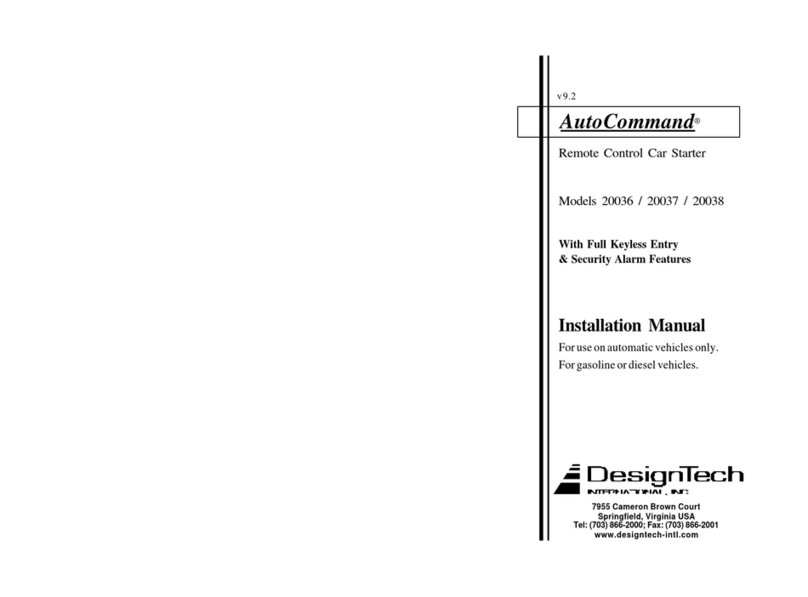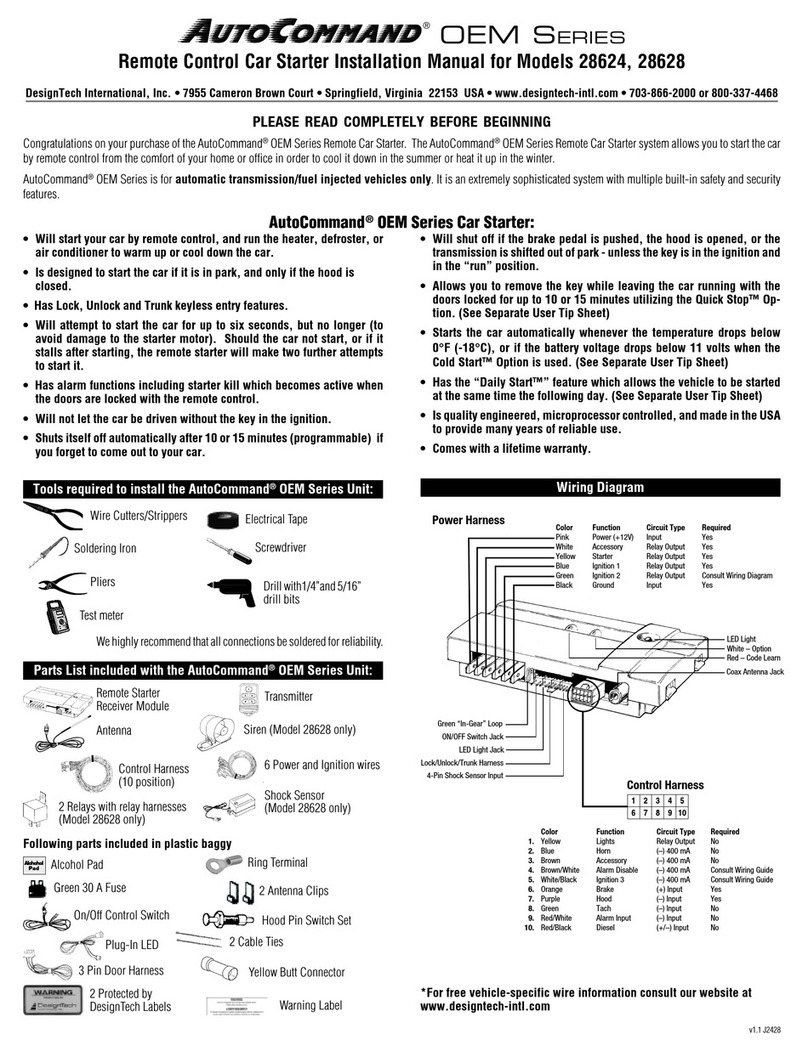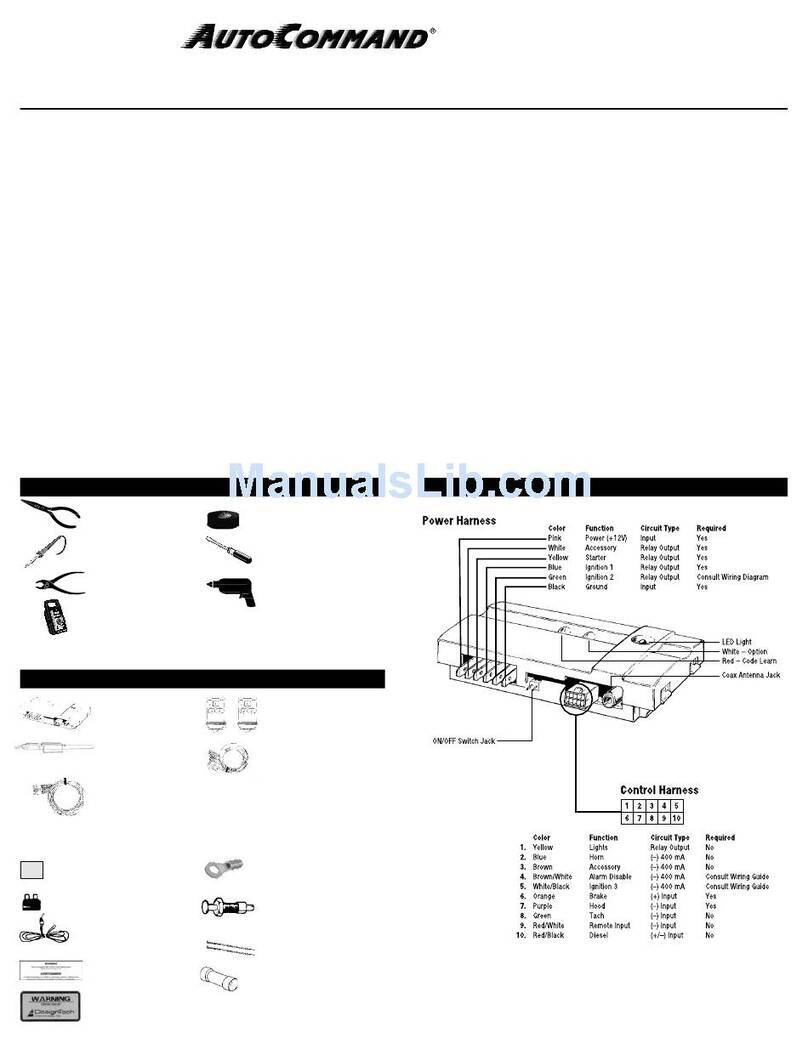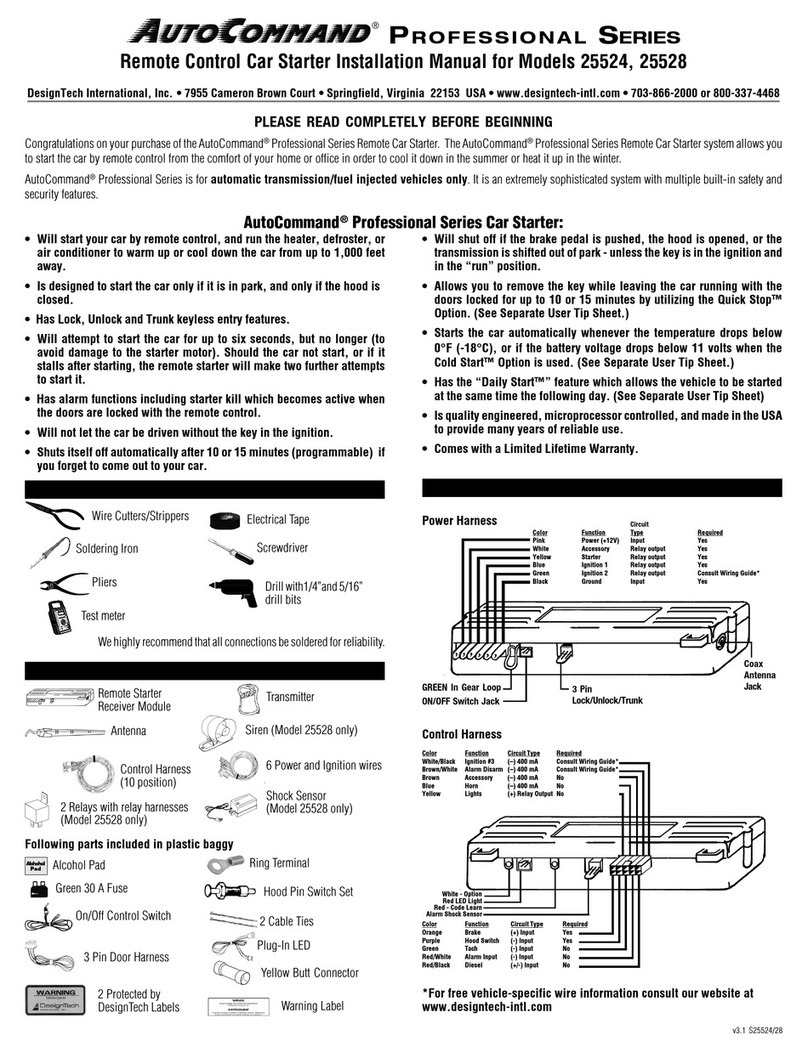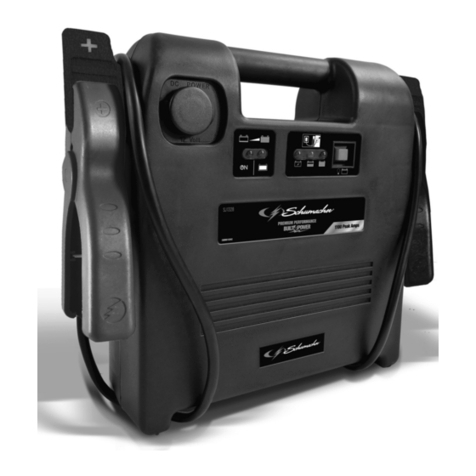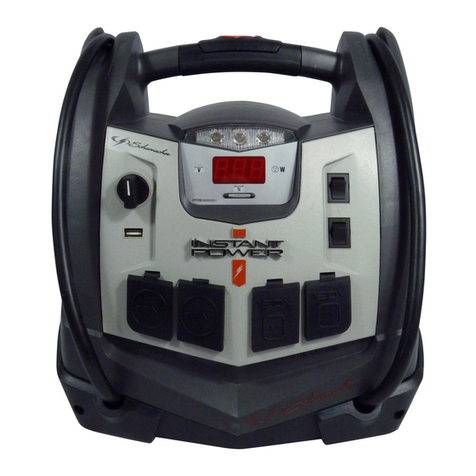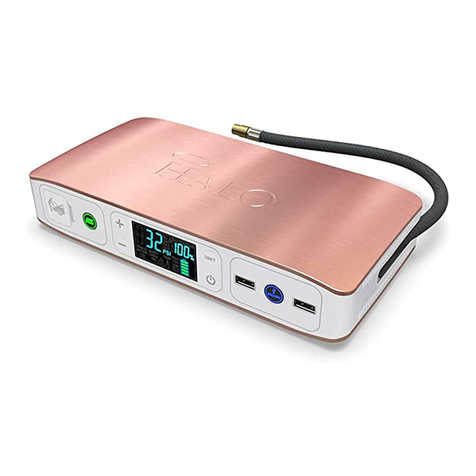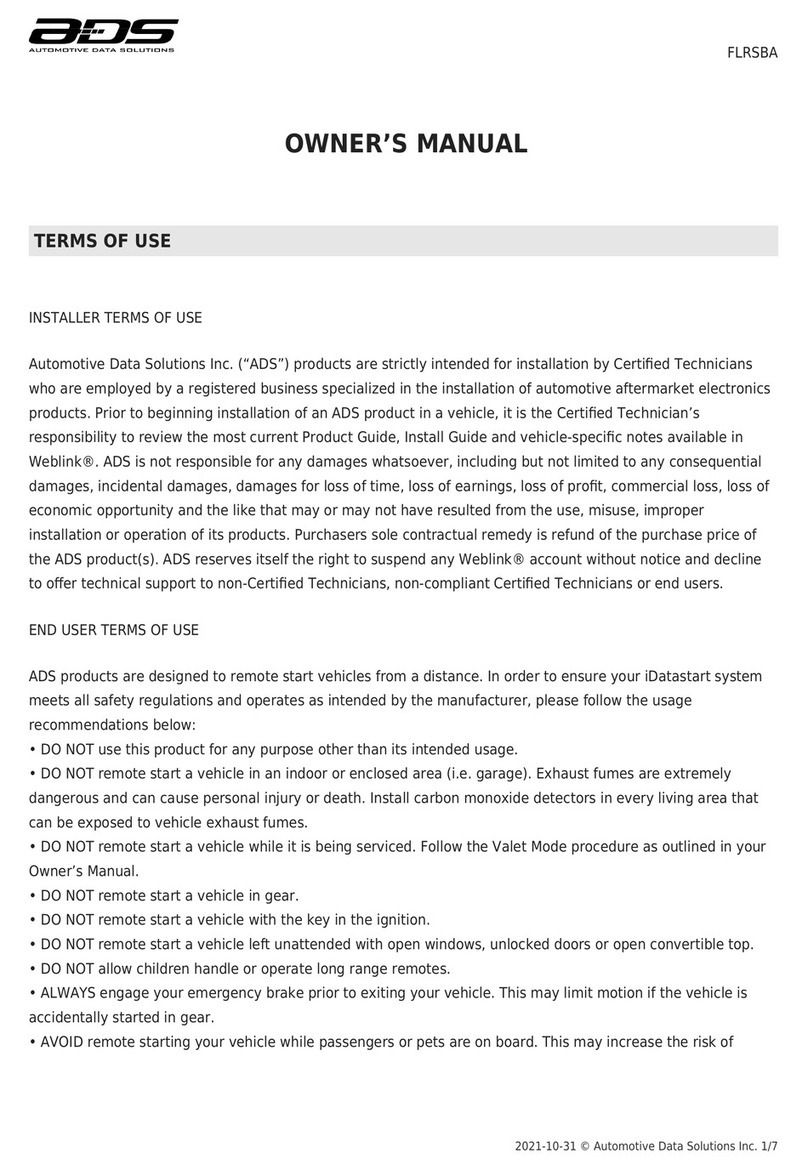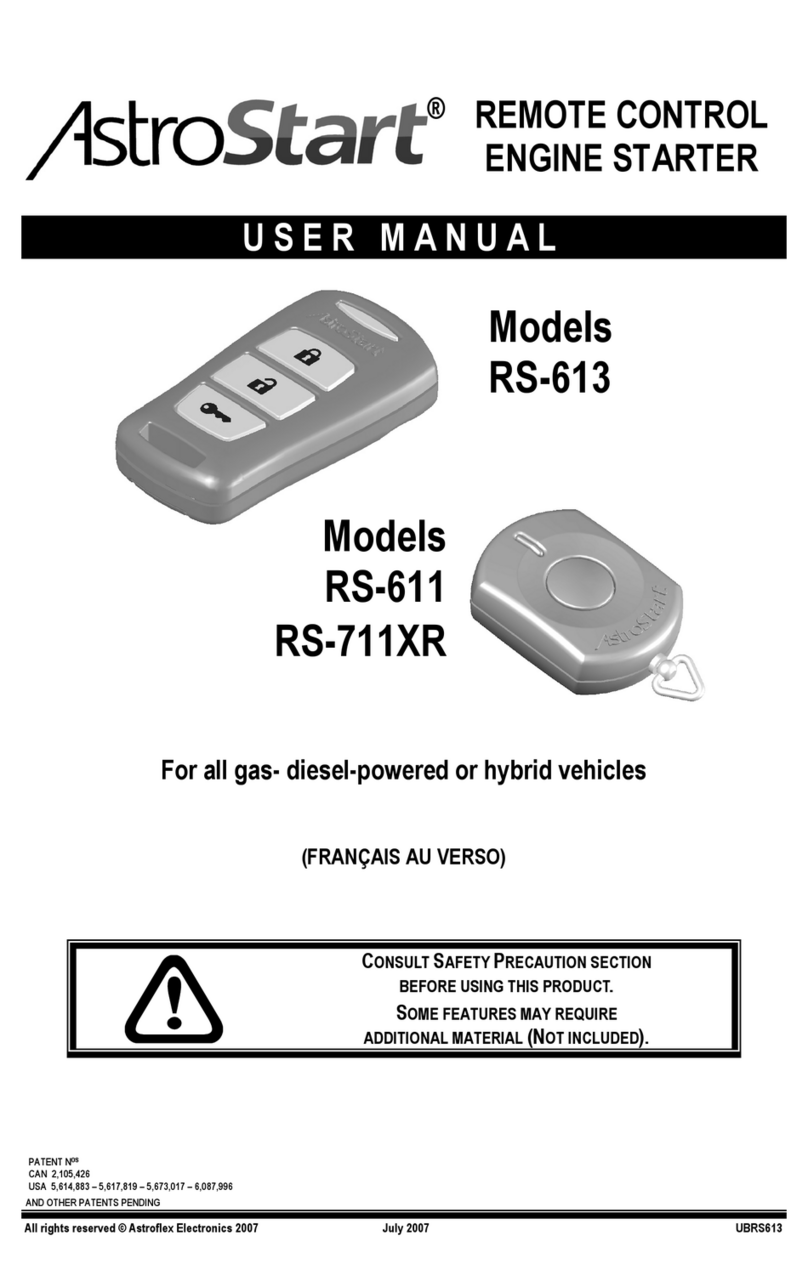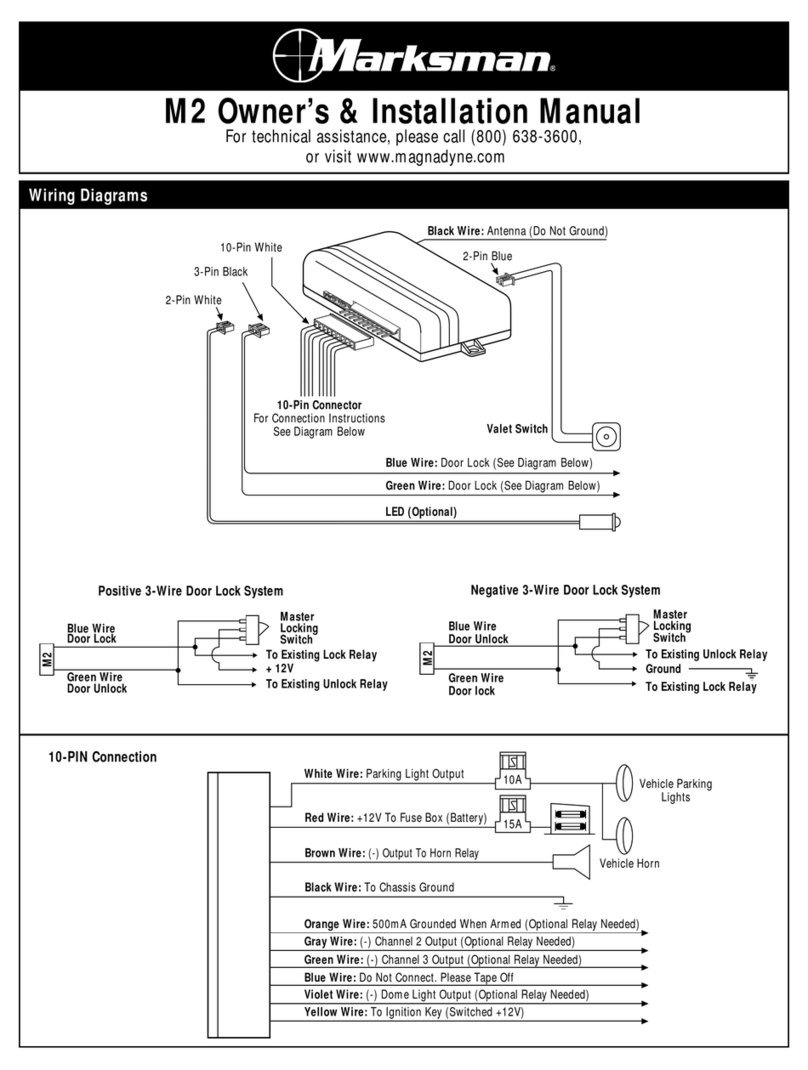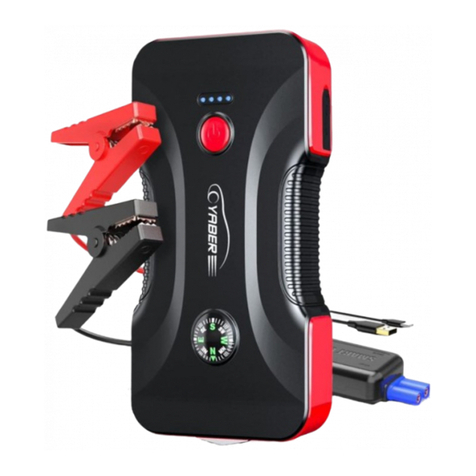AutoCommand 40026 User manual

1v3.2 (4xx26)
Tools required to install the AutoCommand®Unit:
Wire Cutters/Strippers
Soldering Iron
Pliers
Testmeter
We highly recommend that all connections be soldered for reliability.
Parts List included with the AutoCommand®Unit:
Remote Starter Receiver Module
Transmitter
Antenna
Control Harness (6 position)
6 Power & Ignition Wires
Yellow Headlight Wire
Alcohol Pad
Green 30 A Fuse
On/Off Control Switch
Ring Terminal
Hood Pin Switch Set
2 Cable Ties
Yellow Butt Connector
Remote Car Starter Installation Manual for Model 40026
WARNING
This car is equipped with a remote control starting device.
Disable before working on car!
AVERTISSEMENT
Co véhicule est équipé d’un systéme de démarrage á distance. Mettez-le hors
fonctuin avant d’eflectuer toule opération d’entretian ou de répanation!
DesignTech International, Inc. • 7955 Cameron Brown Court • Springfield, Virginia 22153 USA • www.designtech-intl.com • 703-866-2000 or 800-337-4468
PLEASE READ COMPLETELY BEFORE BEGINNING
Congratulations on your purchase of the AutoCommand®Remote Car Starter. AutoCommand®Remote Car Starter allows you to start the car by remote
control from the comfort of your home or office in order to cool it down in the summer or heat it up in the winter.
AutoCommand®is for automatic transmission / fuel injected gasoline vehicles only. Please see pages 6-7 for important information about vehicles with
factory anti-theft systems. AutoCommand®is an extremely sophisticated system with multiple built-in safety and security features.
AutoCommand®Remote Car Starter:
• Shuts itself off automatically after 10 or 15 minutes (pro-
grammable) if you forget to come out to your car.
• Will shut off if the brake pedal is pushed, the hood is opened, or
the transmission is shifted out of park - unless the key is in the
ignition and in the “run” position.
• Is quality engineered, microprocessor controlled, and made
in the USA to provide many years of reliable use.
• Comes with a Limited 2-Year Warranty.
• Will start your car by remote control, and run the heater, defroster,
or air conditioner to warm up or cool down the car.
• Is designed to start the car if it is in park, and only if the
hood is closed.
• Will attempt to start the car for up to six seconds, but no
longer (to avoid damage to the starter motor). Should the
car not start, or if it stalls after starting, the remote starter
will make two further attempts to start it.
• Will not let the car be driven without the key in the ignition.
Alchohol
Pad
Warning Label
2 Protected by
DesignTech Labels
The following parts are included in the plastic bag:
Color Function Circuit Type Required
Purple Hood Switch (-) Input Yes
Orange Brake (+) Input Yes
Blue Horn (-) 400mA Output No
Circuit
Color Function Type Required
Pink Power (+12V) Input Yes
White Accessory Relay output Yes
Yellow Starter Relay output Yes
Blue Ignition 1 Relay output Yes
Green Ignition 2 Relay output Consult Wiring Guide *
Black Ground Input Yes
Small Yellow HeaLights Relayoutput Optional
Power Harness
Color Function Circuit Type Required
Green Tach (-) Input No
Brown/White Alarm Disarm (–) 400 mA Output Consult Wiring Guide*
White/Black IGN 3 (–) 400 mA Output Consult Wiring Guide*
Control Harness
*For free vehicle-specific wire information consult our website at
www.designtech-intl.com
ON/OFF Switch Jack Coax
Antenna Jack
Electrical Tape
Screwdriver
Drill with
1/4”and 5/16”
drill bits
Wiring Diagram

2
v3.2 (4xx26)
On cars with airbags, you may notice bright yellow tubes
or harnesses marked SRS (Supplemental Restraint Sys-
tem) underneath the steering column area. DO NOT tamper
with these wires in any way, to prevent personal injury
and/or damage to the air bag system.
On GM rear-wheel drive vehicles built prior to 1995 and
Dodge Dakota trucks built prior to 1996, see the last page
of this instruction manual.
Battery gases are explosive.
Do not smoke while working near the car’s battery.
NoteNote
NoteNote
Note
::
::
: Some installers connect a battery charger to the vehicle’s bat-
tery during installation. This is fine, but it must be removed before
running the vehicle under remote starter control.
When running the wires through the car’s firewall, be sure
to protect them from sharp metal edges and from hot
surfaces on and around the engine.
INSTALLATION INSTRUCTIONS
1. Before You Start
Please read through the entire installation manual before beginning.
Always leave a window open to avoid locking your keys in your car.
IMPORTANT:
After having read the entire manual, start the installation
by putting the yellow WARNING STICKER in the engine compartment.
Choose a surface that is clean and readily visible when the hood is
open.
POWER & IGNITION HARNESS
The remote starter module will be installed under the dash once all
wiring has been completed. Do not mount the module at this time!
You will need to check the red diagnostic LED light as the installa-
tion progresses.
Locate (or drill) a hole in the firewall to run the
PURPLE and GREEN wires of the Control Harness and the PINK wire
of the
Power Harness into the engine compartment. The remaining
short wires stay in the passenger area. Leave about a foot of the wire
harness under the dash for ease of working and visual access to the
diagnostic light.
The Installation Information section of our web site
www.designtech-intl.com is available 24 hours/day to provide you
with free, up-to-date vehicle wiring information for your particular
vehicle after you log in.
Note: Always connect the
Pink
and
Black
wires before connecting
any of the other wires. Do not insert the fuse until step 11.
2. Black Wire (16 AWG) - Ground
Connect the BLACK
wire to a very good, clean chassis ground in the
driver’s kick panel area. Use the small ring terminal. (The thin metal
bracing around or beneath the dash board is not always adequate.)
3. Pink Wire (12 AWG) - Power (+12 Volts)
Connect the ring terminal at the end of the short PINK
wire to the +12
Volt terminal of the battery. Run the long pink wire through the firewall
of your vehicle. Join the remaining ends of the power wire together
by soldering them. Tape with electrical tape to leave no exposed
wires. Alternatively, you may wish to use the yellow butt connector,
but we recommend soldering. Wait to insert the 30 amp green fuse
into the holder until step 11.
Note:
Failure to properly install the fuse holder and 30 amp fuse to the
pink wire to the battery voids all product warranties.
Ignition Key Diagram for Steps 4-7
The vehicle’s wires are found coming off of
the key switch. Remove the panel under the
steering column to access these wires.
4. Blue Wire (14 AWG) - Ignition 1
Connect the BLUE wire to the ignition 1 wire of your vehicle. This wire
will measure +12 Volts on the test meter in the “run” and
“start” posi-
tion, and is off in the “lock/off” and “accessory” positions.
5. Green (14 AWG) - Ignition 2
Connect the GREEN wire to the Ignition 2 wire in the vehicle. The
Ignition 2 wire can function in several different ways in your vehicle.
It is important to understand how it works. The Ignition 2 wire will
usually measure +12 Volts in the “run” position and is off (ground) in
the “lock/off” and “accessory” positions. In certain vehicles, it may
also show +12 Volts in the “Start” position or Ignition 2 may turn OFF
during “Crank” and turn back ON after the starter disengages. Care-
fully note the function of the Ignition 2 wire. If the Ignition 2 turns
OFF during “Crank”, see Changing Ignition 2 Function in section 23.
If Ignition 2 stays ON during “Crank,” no options need to be changed.
Please refer to our wire color information available at
www.designtech-intl.com
6. White Wire (14 AWG) - Accessory
Connect the WHITE wire to the accessory wire which is +12 Volts in the
“run” and “accessory” position, but off in the “start” and “off” posi-
tions. In most GM vehicles, connect the white wire to the orange wire
that is hot in “run” only.
7. Yellow (14 AWG) – Starter
Connect the
YELLOW wire to the starter wire. This wire will measure
+12 Volts on the test meter in the “start” position only.
Note:
Most Nissan vehicles have two starter wires. Connect both
starter wires of the vehicle to the
YELLOW start wire of the remote
starter.
8. Dash-mount LED-On/0ff Control Switch
Connection of the LED-On/0ff Control Switch is mandatory. Do not
let the switch wires touch ground. Mount the control switch so that
it is easily seen and accessible. If a hole is to be drilled to route the
switch wire, make sure there is enough clearance behind and noth-
ing can be damaged by the drill. Use a 1/4" drill-bit for the mounting
hole. Plug the switch connector into the module just to the right of
the control harness. The LED will turn Red when the switch is turned
ON and the LED will turn Green when the switch is turned OFF.
CONTROL HARNESS
(ALL WIRES ARE THE SMALLER 18 AWG SIZE)
9. Purple Wire - Hood Pin Switch -
Control Harness
The hood pin switch MUST be installed
with the remote starter. It prevents op-
eration of the remote starter when the
hood is open and is used to initialize
and program the unit. Connect the
PURPLE wire to the hood pin switch us-
ing the red connector.
WARNING
This car is equipped with a remote control starting device.
Disable before working on car!
AVERTISSEMENT
Ce véhicule est équipé d’un systéme de démarrage a distance. Mettez-le
hors fonction avant d’eflectuer toute opération d’entretien ou de réparation!
How to share a hood pin
switch with an alarm
To Remote Starter
To Alarm

3v3.2 (4xx26)
awg) wire to the car’s tach wire under the hood (normally the nega-
tive side of the coil or tach output of coil pack). After you have
connected the GREEN wire, you need to teach the remote starter the
vehicle’s tach rate at idle. Proceed to step 12B.
Note:
You must have already initialized the remote starter in Step 11.
12B. Tach Rate Learning
Note:
Only use if the tachometer sensing method is chosen. The
tach option must be selected first. See the Setting Program Features
section.
A. Connect the GREEN tach wire to the vehicle's tach
wire under the hood.
B. Open Hood.
C. Start vehicle with key (engine running)
D. Press and HOLD brake pedal.
E. Press the Control Switch button 3 times.
F. Release the brake pedal.
G. The LED on the Control Switch will flash RED 3 times.
The tach rate is being recorded and averaged for the next 5 seconds.
The unit will flash the lights output 3 times to signal the unit has
successfully learn the tach signal.
H. Turn the key to Off, (engine Off).
I. Close the hood.
J. Push the Control Switch push button so the LED is showing
RED.
K. Push the start button on the transmitter, vehicle should cleanly
start and remain running.
OPTIONAL STEPS
13. Yellow Wire - Headlights/Parking Lights - Seperate Tab Connector
Connection of the YELLOW wire allows you to activate the low beam
headlights or parking lights for remote start and lock status. After the
remote starter has started the car, the lights will remain on until the
remote starter shuts off after 10 minutes, or when the brake pedal is
pushed, or when the car is put into gear.
This is a relay +12 Volts
output. Connect the
YELLOW wire to the wire that has power when
the lights are on.
14. Blue - Horn/Siren - Control Harness
The BLUE wire signals the horn to honk (or siren to chirp) once each time
the remote starter starts the vehicle and each time the locks are locked or
unlocked. Connect the blue wire to the factory horn wire which is often
found running down the steering
column. It will normally show +12
Volts at rest and the voltage will dis-
appear when the horn is honked.
This is a 400 mA transistor ground
output which MUST drive a relay if
using a siren or positively triggered
horn.
15. Brown/White - Alarm Disable - Control Harness
The BROWN/WHITE wire is Alarm Disable, which will give out a quick
negative pulse just before unlocking the doors or starting the
vehicle. This wire can be used to turn off the factory alarm system
in vehicles which have them. In most vehicles, this wire is located
in the driver’s kick panel.
Note:
If you already have a hood pin switch which is being used by a
car alarm system, you may share the wiring – but be sure to diode
isolate each wire going to the hood pin switch with the bands of
diodes pointing towards the pin switch as shown on the previous
page.
10. Orange Wire - Brake Shut-off - Control Harness
Connect the ORANGE wire to the brake wire which receives +12 Volts
when the brake pedal is depressed. This wire must be connected. It
arms a critical safety feature which disables the remote starter when
the brake pedal is depressed.
Note:
In some cars, the ignition must be in the “on” position to test
the power in the brake wire.
Note:
If the Ignition 1 & Ignition 2 wires come on whenever the brake is
depressed and the hood is open this just means you need to initialize
the unit in step 11.
11. Initializing the Remote Starter
BEFORE THE UNIT WILL DO ANYTHING FOR THE FIRST TIME, YOU
MUST INITIALIZE THE REMOTE STARTER
A. Insert the fuse into the pink fuse holder on the pink power wire.
B. The remote starter requires the installer to open the hood and
then press and hold the brake pedal. Note: The ignition/dash
lights will come on if the unit is not initialized.
C. While depressing the brake (with the engine off and the hood
open) turn the ignition key to the “RUN” (not “start”) position.
D. Put the car in “DRIVE” from the “PARK” position.
E . Put the car back in “PARK” and release the brake.
F . Turn the key off and remove the key.
Note:
Confirm initialization by looking at the control switch/LED. If
the control switch/LED is Green, the unit is initialized. Push the
control switch once, LED turn Red. Unit is ready to try to remotely
start.
If the unit is not initialized, control switch/LED is Off. The dash lights
will come on (the remote starter powers up the ignition wires) when
the brake is depressed or the hood is open, and the control/valet
switch is on. REPEAT STEPS A THROUGH G. See the colored Trouble
Shooting Sheets if necessary.
12A. Green Wire - Tach Input - Control Harness
The Remote Starter has two ways of monitoring the car during the
starting process. Both ways will ensure a clean, accurate start. Read
about both methods before deciding which one to use. Normally you
should try the “No Tach™” method first.
“No Tach™” Starting (recommended for most vehicles)
This starting method does not require the connection of the GREEN
tach wire. This method will start the car by reading the car’s voltage
before attempting to start, and then looking for a voltage increase when
the alternator kicks in. This feature automatically takes into account
voltage, temperature, and the time since the vehicle was last run. The
“No-Tach™™
™™
™””
””
”
starting is preset at the factory and you can skip step 12B
if you would like to use it. Note that if the vehicle is hard to start, set
option #3 [Setting Program Features section (step 22)] for “extended
crank.”
Tachometer sensing
If the vehicle is generally hard to start (i.e. requiring a cranking time
of more than 1 second) you will get more accurate starting with the
tachometer sensing starting method. This method starts the car by
reading the engine speed (tach) information from a wire under the
hood. If you choose tachometer sensing, connect the GREEN (18
Positive Horn/Siren Relay

4
v3.2 (4xx26)
Ignition 3
To LARGE 12 Volt
Constant Wire
(Found in Ignition
Switch Wire
Harness)
To Additional
Ignition Wire
(in vehicle)
87
86
White/Black Wire
From
Remote Starter
85 30
87A
Check to make sure the hood pin switch is depressed
when the hood is closed and the correct brake wire is
hooked up.
3flashes No Tach or Stalled. Review Step 12 and make
sure the no tach/tach wire option is programmed cor-
rectly.
4flashes Received another remote input from the transmitter (re-
mote pressed before unit completed its cycle)
5flashes Transmission was shifted into gear. Cut the small green
in-gear wire loop inside of the receiver module. Open the
module case to access the loop.
6flashes Low battery voltage, or may be missing an ignition wire
which powers up the alternator
8flashes Over current - One of the 400 mA (-) transistor outputs
(horn, lights, or Ignition #3) of the control harness is
driving too much current. Make sure to use a relay where
necessary.
12 flashes The Control Switch was turned off while the starter was
running.
20. Setting Program Features:
The remote starter unit has many special features available. You will
not need to use these special features in most situations. The factory
settings will operate most vehicles.
Feature # Factory Setting (Green LED) Option (Red LED)
1 “No-Tach” Tach Mode
2 10 Min. Run Time 15 Min. Run Time
3 Normal Crank Extended Crank
4 N/A N/A
5 Normal Ignore Voltage Meter
6 N/A N/A
7 “Enable” feature No “Enable”
8 Normal Daytime Running Lights
Option #1 No-Tach Tach Mode
This option sets the starting method. The factory setting uses “No-
Tach” starting. If you wish to use the tach to start, follow the instruc-
tions in the Tach Rate Learning section (step 12B).
Option #2 10 Min. Run Time 15 Min. Run Time
This option gives you a choice of run times.
Option #3 Normal Crank Extended Crank
This option will add 50% more crank time to the NoTach™ starting
feature.
Option #7 “Enable” Feature No “Enable”
This option cancels the “enable” mode safety feature. The “enable”
mode requires that the driver push the control switch “OFF” and then
“ON” again each time the driver removes the key from the ignition in
order to “enable” the vehicle for remote starter control. The switch
light will shine red when ready. This feature guards against undes-
ired starting of the vehicle by remote control.
You must keep this
option as enable on all GM rear wheel drive and Dodge Dakota vehicles
manufactured prior to 1996.
Option #8 Normal Daytime Running Lights
This option will turn the headlights on about 10 seconds after it sees
the ignition turn on and will turn the lights off when the ignition is
turned off.
16. White/Black Wire - Ignition #3 - Control Harness
The WHITE/BLACK
wire, is a ground output that acts just like the
Ignition 1 or Ignition 2 relay outputs (active in the “run” and “crank”
positions). This wire is a 400 mA negative transistor output and MUST
be set up to power a relay
(not included). It can be used to power the
third ignition wire at the key (necessary for most Ford vehicles).
This is the wire that can also be
used to bypass a passive anti-
theft system by hooking it up
to the Universal Alarm Bypass
Module. See the Factory Anti-
Theft System Section at the end
of the instructions.
REQUIRED FINAL STEPS
You must have hooked up all required wires and completed Initializa-
tion (Step 11) to proceed forward.
17. Trying the Unit Out
WARNING: Be prepared to apply the brake during this testing.
A. Close the hood and fully apply the emergency brake
B. Place the vehicle in Park.
C. Push the On/Off switch once – the red LED will turn on solid Red.
D. Once all the wiring is checked and is correct, press the Start
button on the transmitter.
E. The car should start and continue to run for ten minutes. Make
sure that the engine shuts down if the car is shifted out of park,
the hood is opened, the brake is pressed or the start button is
pushed again. If the car does not start, see Special Cases or Code
Learning section under Special Cases.
18. The Antenna
Feed the antenna around under the dash and up the inside of the
right or left windshield post and over the top of the windshield. Clean
the windshield with the rubbing alcohol pad, wait to dry. Remove the
paper backing from the double sided tape to mount the last eight
inches of the antenna behind the rear view mirror. The more exposed
the antenna is, the better the range and performance. Now plug the
end of the antenna into the remote starter module. In some vehicles
you will get better range performance if the antenna is pointing verti-
cally downward from the top of the windshield.
The wiring section of the installation is now complete. Be sure to cap
all unused wires so as to prevent short circuits, and mount the
module securely under the dash. When tying up and mounting
the unit, be sure to avoid any moving parts (steering column,
pedals) and sharp edges.
19. Trouble Shooting with the Self Diagnostics
The remote starter contains a built in diagnostic routine that will
indicate why the unit started or why the unit turned off the car the
last time that the unit was used.
To activate the diagnostic mode for why it turned off, simply turn the
On/Off control switch to the “OFF” position, the LED will turn Green.
In a few seconds, the Green LED on the switch will flash 1 to 12 times
to identify the problem. See the chart below for an explanation of the
flashes:
1flash 10/15 minute time out. Unit should be fine. Make sure
the transmitter is working properly.
2flashes Unit turned off because Brake or Hood was activated.

5v3.2 (4xx26)
Programming An Option:
If you want the factory setting, DO NOTHING and skip this section. If
you want to change one or more of the features, then continue with
the following procedures:
1. Open the hood.
2. Press and HOLD the brake pedal.
3. Quickly press and release the programming button once.
4. Release the brake pedal.
The control LED will flash Red 1 time1 (signaling that you are now in
the Option Programming mode).
The LED color reflects the first option (Green LED is for Factory set-
ting, Red LED is for Optional setting).
Pressing the brake pedal advances to the next option. By continuing
to push the brake pedal, the user will advance through all of the
options and then start back at Option #1 again.
After pushing the brake pedal, the LED flashes Red (the # of the
option) before turning Red or Green, reflecting the state of the op-
tion (Green for factory setting, Red for Optional setting).
If no options are selected or changed after 6 seconds the unit will
automatically exit programming.
Push the control switch so the LED is Red, the unit is now ready.
21. Changing Ignition 2 Function
Many newer vehicles turn off the Ignition 2 wire while the starter is
cranking. In these vehicles it is very important to have the remote
starter copy the starting sequence of the key exactly; otherwise the
vehicle's computer may show a fault code or not allow the vehicle to
start at all. For most GM vehicles, you do not need to change this
option.
To turn the thick GREEN Ignition 2 wire off during crank:
1. Unplug all wires and connections from the remote start module.
2. Open the case of the remote start module.
3. Look for a small two-pin jack just next to the Red programming
push button.
4. Move the small black jumper to fit over BOTH pins on the jack.
5. Close the case and plug in all of the wire connectors.
The remote start module will turn OFF Ignition 2 while the starter is
cranking. Removing the jumper will return the unit to the factory
setting.
SPECIAL CASES
1) How to Use a Relay
Many of the optional steps require a relay to be hooked up. The most
common relay used for this type application is the Bosch type relay
(DesignTech #20043 or Radio Shack Cat.# 275-226). Use the diagram
for a typical hookup. If you have another relay then you need to know
that pins 85 and 86 in this diagram relate to the coils of the relay. Pin 30
is the ‘common’, and pin 87 is the ‘normally open’ contact. If your relay
has a pin 87A in the middle it is the normally closed contact and is only
used for lock/unlock situations. (The diagram is typical for an Ignition 3
or trunk application).
From
Remote
Starter
(-)
To Vehicle's Accessory
+12 V
87
86
85 30
To Ground
To Vehicle's Accessory
+12 V
87
86
From
Remote
Starter
(-)
85 30
+12 V
To supply Ground (-)To supply +12 volt

6
v3.2 (4xx26)
2) Code Learning
Your transmitter is factory coded to the remote starter module with
over 16,000,000 different codes. The remote starter module can
learn the codes of up to 4 different transmitters. If you want to add
additional transmitters to the receiver or if it does not respond to
your transmitter - follow the steps below to teach the receiver the
transmitter code(s):
A. Open Hood.
B. Press and HOLD brake pedal.
C. Quickly push and release Programming button twice.
D. Release the brake.
E. The LED will glow solid Orange.
F. Hold down the LIGHTS button on the transmitter for a second
until you hear the horn honk (or just look for the orange LED to
go out for half a second). The module has now learned the trans-
mitter code. Release the transmitter button.
G. To learn additional transmitters (up to 3 more), within a few
seconds, push the LIGHTS button on another transmitter for a
second or more until you hear the horn honk (or see the orange
LED go out for half a second). Repeat for the remaining trans-
mitters.
H. 5 seconds after the last time the transmitter was learned the unit
exits the code-learning stage. (The Red LED light will turn on
solid when unit exits Code learning).
Note:
Teaching the module a new transmitter code will erase all pre-
vious codes - so all transmitters must be taught. You have only 5
seconds between transmitters to begin teaching a new transmitter.
3) Factory Anti-Theft Systems
Many vehicles come with an anti-theft system that must be tempo-
rarily bypassed for the vehicle to be remotely started. Some systems
use a resistor in the key. Others use a transponder - a small device in
the key that communicates a high security code to the vehicle before
the vehicle will successfully start.
Check the list of vehicles and the types of security systems on the
right. If your vehicle is listed, your vehicle has an Anti-Theft System
that the remote starter MUST temporarily bypass in order to start the
vehicle. More information about the factory anti-theft systems and
vehicle wire colors can be found at the DesignTech web page
www.designtech-intl.com.
DesignTech has developed a Universal Alarm Bypass Module, sold
under part numbers #20402, #27402, or #29402 that will tempo-
rarily bypass a factory anti-theft system when using the remote starter.
Check with your local retailer/installer to purchase this Universal Alarm
Bypass Module or contact DesignTech for more information.
Acura 3.2TL 98+ Transponder
Audi A4,A6,A8 98+ Transponder
Acura CL 97+ Transponder
Acura Integra Transponder
Acura NSX Transponder
Acura RL 98+ Transponder
BMW (all 97 +) Transponder
Buick LeSabre 90 - 01 VATS
Buick Park Ave 91 - 96 VATS
Buick Park Ave 97+ Transponder
Buick Regal 93 -96 VATS
Buick Rendez Vous Transponder
Buick Riviera 93 -96 VATS
Buick Roadmaster 93 - 96 VATS
Buick Skylark 96-98 Passlock
Cadillac Allante VATS
Cadillac Brougham VATS
Cadillac Catera 97+ Transponder
Cadillac DeVille 92 - 98 VATS
Cadillac DeVille 99+ Transponder
Cadillac Eldorado 89 - 98 VATS
Cadillac Eldorado 99+ Transponder
Cadillac Escalade 00+ Passlock
Cadillac Fleetwood 90 - 96 VATS
Cadillac Seville 90 - 98 VATS
Cadillac Seville 99+ Transponder
Chevrolet Astro Van 98+ Passlock II
Chevrolet Avalanche 01 Passlock
Chevrolet Blazer 98+ Passlock II
Chevrolet Camaro 86 + VATS
Chevrolet Cavalier 96-99 Passlock
Chevrolet Cavalier 2000+ PasslockII
Chevrolet Corvette 88 + VATS
Chevrolet Express 97+ Passlock
Chevrolet Impala 2000+ Passlock II
Chevrolet Lumina 96 -99 VATS
Chevrolet Malibu 97 -01 Passlock II
Chevrolet Monte Carlo 96-99 VATS
Chevrolet Monte Carlo 00+ Passlock II
Chevrolet Pickup Full-size 98+ Passlock II
Chevrolet S-10 98+ Passlock II
Chevrolet Silverado HD 01 PasslockII
Chevrolet SSR 01 Passlock
Chevrolet Suburban 98+ Passlock II
Chevrolet Tahoe 98+ Passlock II
Chevrolet Trailblazer 01+ PasslockII
Chevrolet Van 98+ Passlock II
Chevrolet Venture 99+ Transponder
Chrysler Concorde 98+ Transponder
Chrysler LHS 99+ Transponder
Chrysler PT Cruiser 00+ Transponder
Chrysler Sebring Conv. 98+ Transponder
Daewoo Leganza Transponder
Dodge 300 M 99+ Transponder
Dodge Intrepid 98+ Transponder
Dodge Neon 00+ Transponder
Ford Contour 97 + Transponder
Ford Crown Victoria 98+ (option) Transponder
Ford Excursion 01+ Transponder
Ford Expedition 97+ Transponder
Ford Explorer 98+ Transponder
Ford Focus 01+ Transponder
Ford Mustang 98+ Transponder
Ford Pick Up (optional) Transponder
Ford Ranger 99+(optional) Transponder
Ford Sport Trac 01 Transponder
Ford Taurus 96 + Transponder
Ford Windstar 2000 + Transponder
GMC Envoy 01+ Passlock II
GMC Jimmy 98+ Passlock II
GMC Safari 98+ Passlock II
GMC Denali 99+ Passlock II
GMC Sierra Passlock II
GMC Sonoma 98 + Passlock II
GMC Suburban 98+ Passlock II
GMC Yukon 98+ Passlock II
Honda Accord 98+ Transponder
Honda Odyssey 98+ Transponder
Honda Prelude 98+ Transponder
Honda S2000 Transponder
Infiniti I30 98+ Transponder
Infiniti Q45 98+ Transponder
Infiniti QX4 Transponder
Jaguar (all 98+) Transponder
Isuzu Hombre 98+ Passlock II
Jeep Grand Cherokee 99+ Transponder
Jeep Liberty Transponder
Jeep TJ (Wrangler) 99+ Transponder
Lexus (all 97+) Transponder
Lincoln Blackwood Transponder
Lincoln Continental 97+ Transponder
Lincoln LS 2000+ Transponder
Lincoln Mark VIII 97+ Transponder
Lincoln Navigator 97+ Transponder
Lincoln Town Car 97+ Transponder
Mazda Tribute Transponder
Mercedes (all 97+) Transponder
Mercury Cougar 99+ Transponder
Mercury Grand Marquis Transponder
Mercury Mountaineer 98 + Transponder
Mercury Mystique 97+ Transponder
Mercury Sable 96+ Transponder
Mini Cooper 02 Transponder
Mitsubishi Eclipse Transponder
Mitsubishi Galant Transponder
Nissan Frontier S/C Transponder
Nissan Maxima 98+ Transponder
Oldsmobile Achieva 95 Passlock I
Oldsmobile Achieva 96+ Passlock II
Oldsmobile Alero 99+ Passlock II
Oldsmobile Aurora VATS
Oldsmobile Bravada 98 Passlock II
Oldsmobile Cutlass 97+ Passlock II
Oldsmobile Eighty-Eight VATS
Oldsmobile Intrique 98+ Passlock II
Oldsmobile Ninty-Eight VATS
Oldsmobile Silhoutte 99 Transponder
Pontiac Aztek 01 Transponder
Pontiac Bonneville 89+ VATSPontiac
Firebird 88+ VATSPontiac
Grand Am 96 - 98 Passlock
Pontiac Grand Am 99+ Passlock II
Pontiac Grand Prix 92 – 96 VATS
Pontiac Grand Prix 97+ Transponder
Pontiac Montana 99+ Transponder
Pontiac Sunfire 96-99 Passlock I
Pontiac Sunfire 2000+ Passlock II
Porsche (all 97+) Transponder
Saab (all 97+) Transponder
Saturn 97-99 Factory Alarm
Saturn 00+ Transponder
Subaru Legacy 00+ Transponder
Subaru Outback 00+ Transponder
Toyota Avalon 98+ Transponder
Toyota Camry 98+ Transponder
Toyota Highlander 01+ Transponder
Toyota Land Cruiser 98+ Transponder
Toyota Solara 99 + Transponder
Toyota Supra 98+ Transponder
Volkswagen Beetle 98+ Transponder
Volkswagen Golf 98+ Transponder
Volkswagen Passat 98+ Transponder
Volvo (all 98+) Transponder
List of vehicles and the types of factory anti-theft systems:
VV
VV
Vehicle:ehicle:
ehicle:ehicle:
ehicle: System:System:
System:System:
System: VV
VV
Vehicle:ehicle:
ehicle:ehicle:
ehicle: System:System:
System:System:
System:

7v3.2 (4xx26)
NOTICE to Installers of Remote Vehicle Starters
DesignTech International DOES NOT recommend installing ANY remote starter in the following vehicles:
Audi 1998+, BMW 1998+, Jaguar 1998+, Land Rover 1998+, Mercedes 1998+, Range Rover 1998+, Volvo 1999+
As with any aftermarket installation, please research and learn as much as you can about the vehicle before you start the install.
All General Motors (GM) rear wheel drive vehicles built prior to 1995 with automatic transmissions and all
Dodge Dakota trucks with automatic transmissions built prior to 1996 have a MECHANICAL type of NEU-
TRAL SAFETY SWITCH. All vehicles built after 1996 use an electrical type of neutral safety switch.
Applying+12 voltsto thestarter wireon anyvehiclevehicleusing amechanicalneutralsafetyswitchwillengage thevehicle’sstarter,
regardless of the shifter’s position. When the shifter is in Park or Neutral, the vehicle will just start up normally. If the vehicle is
accidentallyleft ingear andpoweris appliedto thestart wire,such asbyaremote starter, the vehicle will lurch forward or back as
it attempts to start.
To test if your GM or Dodge vehicle is using a mechanical neutral safety switch system, you will only be able to remove the
key from the ignition switch when the shifter is in the Park or Neutral position.
To prevent this problem from occurring when installing a DesignTech International remote starter on a GM rear wheel
drive vehicle or Dodge Dakota built prior to 1996.
1.You must leave the Enable Feature (option #7) in the factory setting.This is a safety feature that requires the user to push the
control switch OFF (Green light) and then ON (Red light) again each time they exit the vehicle in order for the unit to be operational.
This feature will ensure that the user of the vehicle with the remote starter installed has made a conscious decision to allow the
remote starter to start the vehicle the next time the transmitter button is depressed.
2.You must use the relay drawing below to create a circuit that will prevent the remote starter on these GM and Dodge vehicles from
starting the vehicle unless the key is completely removed from the ignition switch.
As with any aftermarket installation, please research and learn as much as you can about the vehicle before you start the install.
Instructions, technical tips and detailed wiring information is available on our web site: www.designtech-intl.com. Please refer to
theinformationon thewebsite before starting ANYinstallor callDesignTechTechnicalServices at1-800-337-4468or 703-866-2000.
7955 Cameron Brown Ct. • Springfield, Virginia 22153 USA7955 Cameron Brown Ct. • Springfield, Virginia 22153 USA
7955 Cameron Brown Ct. • Springfield, Virginia 22153 USA7955 Cameron Brown Ct. • Springfield, Virginia 22153 USA
7955 Cameron Brown Ct. • Springfield, Virginia 22153 USA
Tel: (703) 866-2000 or (800) 337-4468 www.designtech-intl.comTel: (703) 866-2000 or (800) 337-4468 www.designtech-intl.com
Tel: (703) 866-2000 or (800) 337-4468 www.designtech-intl.comTel: (703) 866-2000 or (800) 337-4468 www.designtech-intl.com
Tel: (703) 866-2000 or (800) 337-4468 www.designtech-intl.com
PLEASE HAVE MODEL NUMBER AND DIAGNOSTIC CODES
READY BEFORE CALLING TECH SUPPORT
Connect to Purple Wire (hood pin
switch) of the Remote Starter
(Purple Wire must also connect to
hood pin switch)
87
86
Connect to
constant
(+) 12 volts
85
30
Connect to the
Ignition Key Sense
Wire from Vehicle's
Ignition Harness
87a
To (-) Vehicle's Ground

USER TIPS AND NOTES
The Remote Car Starter must be “enabled” each time the driver has finished driving and taken out
the key in order for the unit to start the vehicle remotely.
After the key has been removed, you must turn
OFF the control switch (LED turns Green) and then turn it back ON (LED turns Red) again while no key is in the
ignition. This “control switch” or “set switch” prevents unauthorized starting of the car by someone unfamiliar
with the system who may be using the vehicle. If you forget to set the switch, it may also be activated by pushing
the transmitter and holding the button down for ten seconds. To eliminate the need for this, see Option #7
(Setting Program Features).
The AutoCommand®Remote Car Starter will turn the car off if the driver does not insert and turn the key within
10 or 15 minutes. After the AutoCommand®Remote Car Starter has started your car, simply put in the key and
turn it to the “run” or “on” ignition position (not the crank position), push the brake pedal and drive away.
The AutoCommand®Remote Car Starter has numerous safety and security features that make it difficult to steal
your car without the key being in the ignition. Putting your car in gear, pushing the brake pedal or opening the hood
will turn the unit off unless your key is in the ignition and turned to the “run” or “on” position.
If all features are hooked up, your transmitter will function as follows:
Button: Do not push for your first ‘main’ vehicle
Once: To operate vehicle #2 - then any of the 4 buttons (LED flashes red
and green)
Again: For vehicle #3 - then any of the 4 buttons (LED flashes red)
Again: For vehicle #4 - then any of the 4 buttons (LED flashes green)
Button: Once: Start the car with all accessories left on
Again: Stop the car
Button: Once: Turn on headlights for 30 seconds
Again: Turn off headlights
Hold down for 4 seconds for PANIC mode (45 seconds long)
The LED on the transmitter will display 3 different colors - Red for the start button and Yellow for the
lights button. The transmitter is powered by a long life lithium battery (CR 2032 or DesignTech catalog #20059).
The transmitter and receiver are FCC and DOC approved.
Valet Mode:
Pushing the Control switch off (LED turns Green) puts you in Valet Mode. In Valet Mode the Remote Car Starter
and the alarm will not function. This lets you turn off the car starter when having the vehicle serviced. The only
functions that work in Valet Mode are the keyless entry, lights and panic. Simply push the Control switch once
again (LED turns Red) to exit Valet Mode.
The Quick Stop Option™:
You can leave the car running and take the key with you for a quick visit to a store. With the car running, push the
Start button on the keychain transmitter just before pulling out the key (make sure the brake pedal is not pushed).
The car will run for 10 minutes or until you tap the brake or put the car in gear.
Safety Notices:
1. When taking your car in for any service or repairs, disable the remote starter by switching the
Control switch to the OFF position. Inform the mechanic.
2. Never leave your keys in the Ignition when the vehicle is unattended.
3. Do not use this product in a closed garage to avoid excessive carbon monoxide build-up.
LIMITED WARRANTYLIMITED WARRANTY
LIMITED WARRANTYLIMITED WARRANTY
LIMITED WARRANTY
DesignTech International, Inc. Warrants to the original consumer/purchaser that this product shall be
free of defects in material and workmanship under normal use and circumstances for a period of twotwo
twotwo
two
(2) years from the date of original purchase for use. When the original consumer/purchaser returns the
product to DesignTech International Inc., 7955 Cameron Brown Court, Springfield, Virginia 22153,
USA within the warranty period, and if the product is defective DesignTech International, Inc. will at its
option repair or replace such.
This warranty shall constitute the sole liability of DesignTech International, Inc. concerning the product.
DesignTech International, Inc. expressly disclaims all other warranties INCLUDING, WITHOUT
LIMITATION, THE WARRANTIES OF MERCHANT ABILITY AND FITNESS FOR A PAR-
TICULAR PURPOSE. NO PERSON, FIRM , OR CORPORATION IS AUTHORIZED TO AS-
SUME FOR DESIGNTECH INTERNATIONAL, INC. ANY OTHER LIABILITY IN CONNEC-
TION WITH THE SALE AND USE OF THE PRODUCT. DesignTech International, Inc. and agents
and distributors will bear no liability whatsoever for incidental or consequential damages or charges of
any kind.
Some states do not allow the exclusion or limitation of incidental or consequential damages, so the above
disclaimer regarding incidental or consequential damages may not apply to you.
Please complete the warranty registration card below and mail to: DesignTech International, Inc., 7955
Cameron Brown Court, Springfield, Virginia 22153 USA within ten (10) days after date of purchase.
This warranty is void if the product has been damaged or tampered with or if the product or any such
parts have been opened. In all cases of damage during shipment, a claim must be filed with the shipping
carrier and not with DesignTech International, Inc.
This warranty gives you specific legal rights; you may also have other rights which vary from state to
state.
OUT OF WARRANTY REPAIRSOUT OF WARRANTY REPAIRS
OUT OF WARRANTY REPAIRSOUT OF WARRANTY REPAIRS
OUT OF WARRANTY REPAIRS
DesignTech International, Inc. will at its option either (1) replace this product with a functionally similar
(but not necessarily visually identical) refurbished product or (2) repair the original product and return
it to the original consumer/purchaser C.O.D. covering all reasonable repair or replacement charges if the
product is returned prepaid to DesignTech International, Inc., 7955 Cameron Brown Court, Springfield,
VIRGINIA 22153, USA after the two year warranty period has expired.
Please return this registration card within ten (10) days of purchase.
Name_________________________________________________________ User'sAge_________
Address _________________________________________________________________________
City____________________________________ State__________________ Zip_______________
PhoneNumber: Home___________________________ Daytime_______________________
Place of Purchase__________________________________ Date of Purchase________________
Product Purchased:_AutoCommand model 40026_ Purchase Price:____________
Vehicle Make:__________________Vehicle Model:________________Year:__________
This product was purchased for: ( ) Myself ( ) Spouse ( ) Relative ( ) Friend
How did you first become interested in this product?
( ) Retailer NewspaperAd ( ) MagazineAd ( ) In-Store Display
( ) Newspaper / MagazineArticle ( ) Mail Order ( ) Friend / Relative
( ) In-Store Salesperson ( ) Other _____________________
__________ Please send me FREE information on other innovative DesignTech products.
7955 Cameron Brown Court, Springfield,Virginia 22153-2809, USA
Tel: 703-866-2000 Fax: 703-866-2001
v3.2

7955 Cameron Brown Ct. • Springfield, Virginia 22153 USA7955 Cameron Brown Ct. • Springfield, Virginia 22153 USA
7955 Cameron Brown Ct. • Springfield, Virginia 22153 USA7955 Cameron Brown Ct. • Springfield, Virginia 22153 USA
7955 Cameron Brown Ct. • Springfield, Virginia 22153 USA
Tel: (703) 866-2000 or (800) 337-4468 www.designtech-intl.comTel: (703) 866-2000 or (800) 337-4468 www.designtech-intl.com
Tel: (703) 866-2000 or (800) 337-4468 www.designtech-intl.comTel: (703) 866-2000 or (800) 337-4468 www.designtech-intl.com
Tel: (703) 866-2000 or (800) 337-4468 www.designtech-intl.com
PLEASE HAVE MODEL NUMBER AND DIAGNOSTIC CODES
READY BEFORE CALLING TECH SUPPORT
7955 Cameron Brown Ct
Springfield, VA 22153-2809
Place
Stamp
Here
Available Accessories:
Universal Alarm Bypass Module allows remote car starter installation on newer vehicles with factory anti-theft
systems such as VATS, P.A.T.S., Passlock I, Passlock II, Pass-Key III, Saturn, Securlock, and Transponder
systems.
Extra transmitters can be used for more than one user in the family. Up to four transmitters can be used with each
AutoCommand receiver in the vehicle.
The Garage Door Receiver connects with your existing garage door remote control system to let your AutoCommand
transmitter open your garage. Part #30021.
The Long Range Antenna approximately doubles the standard range. Part #20314.
These products can be purchased through your dealer or directly from DesignTech International, Inc.
Part No. Product Cost in US$
20402 Universal Alarm Bypass Module $39.95
(also goes by part no. 27402 or 29402)
24461 Extra 3 button transmitter $49.95
20059 Extra Lithium Transmitter Battery $7.95
20314 Long Range Cellular Style Antenna $59.85
30021 Garage Door Receiver Unit $49.95
20043 Bosch 30 amp relay $9.95
Table of contents
Other AutoCommand Remote Starter manuals
Popular Remote Starter manuals by other brands

Schumacher Electric
Schumacher Electric SL1314 owner's manual
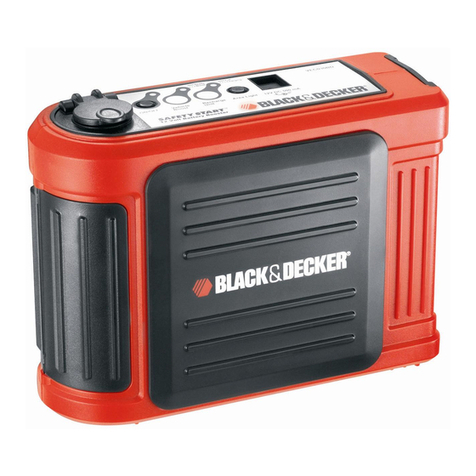
Black & Decker
Black & Decker BDV030 user manual

Omega
Omega RS-3 Operating & installation instructions

CrimeStopper
CrimeStopper EZEE START EZ-10 operating instructions

NPower
NPower 457801 owner's manual

Solar
Solar CarStart CS1000 instruction manual
